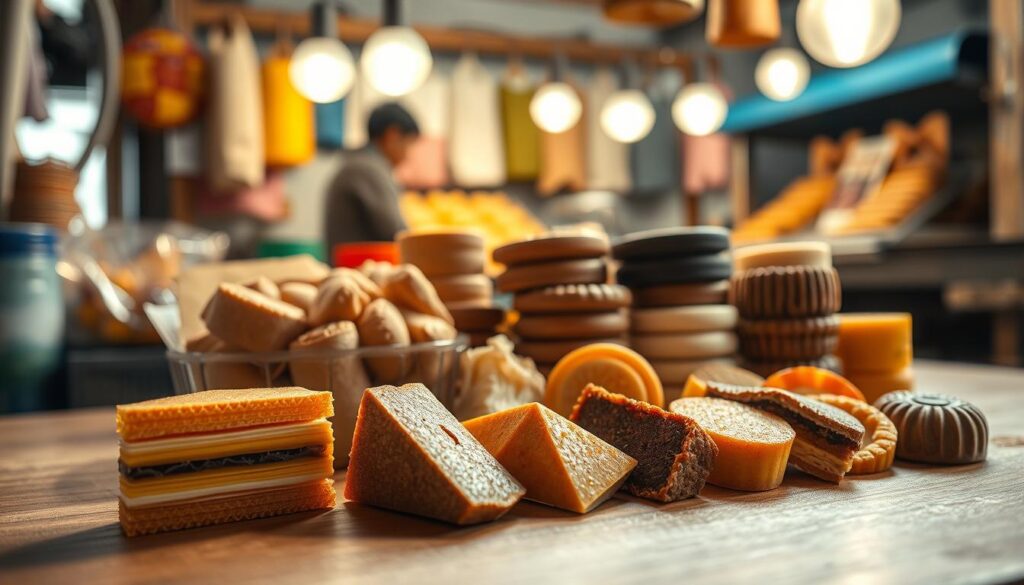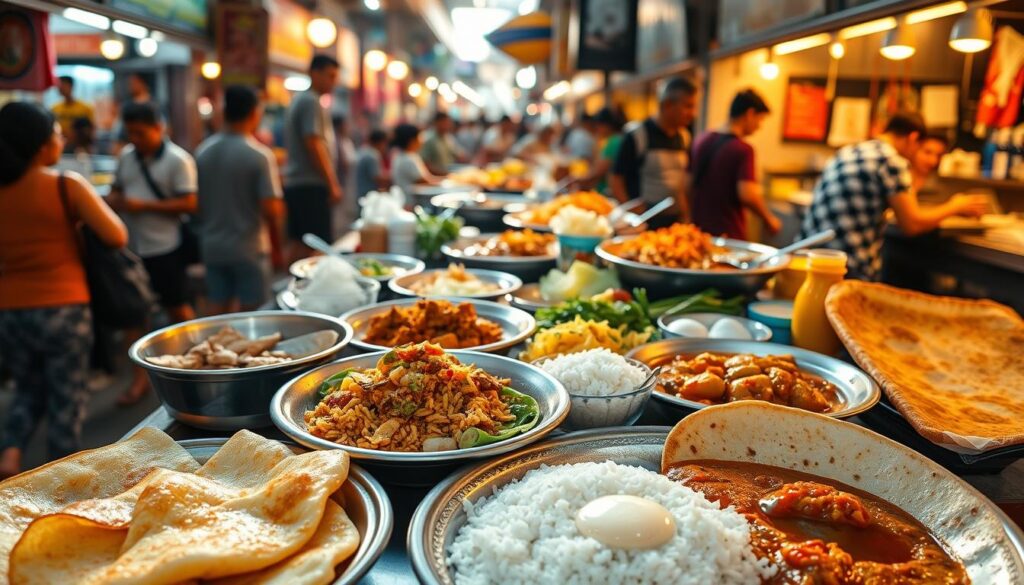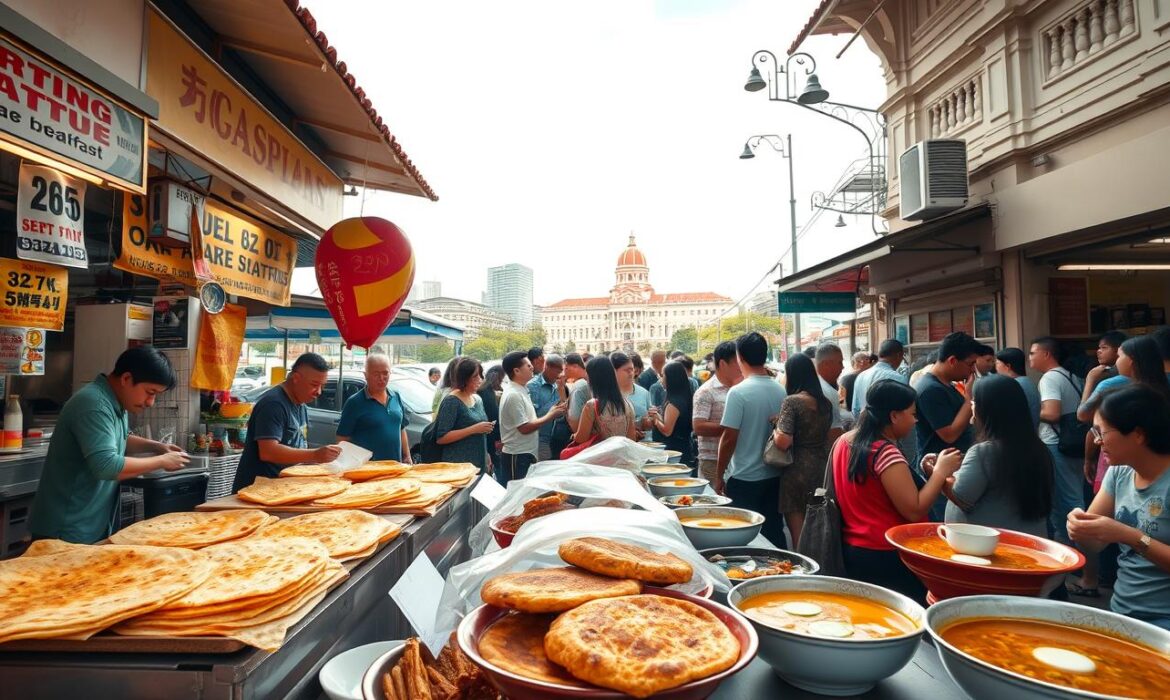Mornings in the Lion City come alive with the sizzle of pans and the aroma of freshly cooked food. Over 70% of locals begin their day at bustling stalls, where time-honored recipes meet affordability. From crispy kaya toast to savory chicken rice, these dishes are more than meals—they’re a way of life.
Hawker centers serve as community hubs, offering flavors passed down through generations. Our curated list highlights 10 must-try spots, including beloved names like Tian Tian and Heap Seng Leong. Each promises authentic tastes without breaking the bank—most plates stay under $5.
Key Takeaways
- Hawker centers are central to daily life, with 72% of residents visiting regularly.
- Classic dishes like kaya toast reflect Singapore’s rich culinary heritage.
- Affordable options abound, with many meals priced below $5.
- Our top 10 list features legendary stalls known for quality and flavor.
- These spots offer a genuine taste of local culture and tradition.
Introduction to Singapore’s Hawker Breakfast Culture
UNESCO-listed hawker culture turns morning meals into a celebration of heritage and flavor. What began in 1819 as street food for migrant workers now thrives in 114 centres nationwide, where 65% of locals grab bites before 9 AM. These hubs are more than eateries—they’re where friendships simmer over shared tables.
Why Hawker Centres Define Mornings
Dawn here means steaming cups of kopi and the crackle of charcoal-grilled toast. “Hawker centres are our communal kitchens,” says a Michelin Guide report, noting their role in feeding laborers since the 19th century. Today, they’re social equalizers—CEOs and construction workers savor the same dish at $3 a plate.
Iconic Dishes You Can’t Miss
From 8 million yearly servings of kaya toast to fluffy putu mayam, these flavors fuel Singapore’s days. Hill Street Tai Hwa’s pork noodles (a Michelin star holder) and Ghim Moh’s chwee kueh—steamed rice cakes topped with radish—showcase the diversity. Each bite carries generations of tradition.
Top 10 Best Hawker Breakfast Spots in Singapore
Generations of flavor come alive at these legendary stalls, where every bite tells a story. From charcoal-grilled classics to Michelin-approved plates, here’s where locals start their day.
Heap Seng Leong: Charcoal-Grilled Nostalgia
Since 1974, this stall has perfected thick kaya toast, crackling over charcoal. Their $3.90 set—buttery coffee and soft-boiled eggs—is a steal.
Tian Tian Chicken Rice: Maxwell’s Crown Jewel
Anthony Bourdain’s favorite, this Maxwell Food Centre gem sells 500 plates daily. Fragrant rice and tender chicken keep lines snaking past dawn.
Ghim Moh Chwee Kueh: Savory Tradition
Steamed rice cakes topped with house-preserved radish ($2.40 for four). The 60-year-old recipe stays unchanged—soft, pillowy, and deeply umami.
Tong Ah Eating House: Triple-Toasted Crisp
Their shatteringly crisp thin kaya toast is a texture marvel. Pair it with kopi for the ultimate morning ritual.
Chin Mee Chin Confectionery: Retro Indulgence
Step into the 1950s with flaky buns and $5.90 sets. The pastel-walled shop feels like a time capsule.
YY Kafei Dian: Hainanese Heritage
Buttery toast sets with aromatic kaya. A nod to Singapore’s Hainanese roots, served fast and fresh.
Lai Heng Handmade Teochew Kueh
Steamed rice cakes with fillings like peanut or yam. Each piece is hand-shaped—a disappearing art.
Selera Rasa Nasi Lemak: Royal Twist
Basmati rice replaces coconut rice here, crowned with crispy anchovies. A halal-certified standout.
Fu Zhou Poh Hwa Oyster Cake
UFO-shaped fritters stuffed with oysters at Berseh Food Centre. Crisp outside, juicy inside.
Hum Jin Pang: Maxwell’s Hidden Gem
Fried dough fritters with sweet or savory fillings. Grab them before they sell out by mid-morning.
Must-Try Dishes at These Hawker Centres
From crispy toast to steamed cakes, these iconic dishes define Singapore’s dawn rituals. Each bite offers a clash of textures and traditions, perfected over decades.
Kaya Toast: Thick vs. Thin
Heap Seng Leong’s kaya toast is a carb-lover’s dream—thick slices charcoal-grilled until golden, slathered with coconut jam. At Tong Ah Eating House, the *shatteringly crisp* thin version pairs perfectly with runny eggs.
YY Kafei Dian adds heritage to the mix. Their recipe traces back to Hainanese military camps, with butter-kaya layers melting into warm bread.
Chwee Kueh vs. Putu Mayam: Texture Showdown
Ghim Moh’s chwee kueh delivers soft, steamed rice cakes topped with crunchy preserved radish. Contrast this with putu mayam at Heaven’s Indian Curry—stringy rice noodles drizzled with *gula melaka* for a sweet finish.
Hearty Plates: Nasi Lemak & Chicken Rice
Selera Rasa reimagines nasi lemak with basmati rice and *ikan kuning* (yellow fish). Tian Tian’s poached chicken rice remains a staple, while Roast Paradise’s smoky version offers a crispy twist.
For Michelin-approved tastes, Liao Fan Hawker Chan’s soy sauce chicken balances tender meat with savory glaze. Each dish proves that morning meals here are anything but ordinary.
Breakfast Spots by Neighborhood
Each neighborhood in Singapore offers unique morning flavors worth exploring. From steamed rice cakes to aromatic curries, local markets serve dishes that reflect their community’s heritage.

Chinatown Complex: Millennium Glutinous Rice
At Chinatown Complex, Millennium Glutinous Rice sells out by noon. Their HK-style rice, packed with dried shrimp and mushrooms, is a savory masterpiece. Regulars swear by its perfectly sticky texture and umami depth.
Bukit Merah: Kuehs and Snacks
Bukit Merah’s Kuehs and Snacks is a hidden gem. Their rare Chi Kak Kueh (water chestnut cake) and ang ku kueh with eight fillings—from mung bean to durian—showcase traditional techniques. Each bite is a nod to Peranakan and Teochew roots.
Ghim Moh: Heaven’s Indian Curry
Ghim Moh Market’s food scene shines with Heaven’s Indian Curry. Their putu mayam—rice noodles served on banana leaves with coconut and palm sugar—is a sweet-savory delight. “The banana leaf adds an earthy aroma,” notes a longtime vendor.
- Tiong Bahru: Artisan cafes sit alongside classic kaya toast stalls.
- Joo Chiat: Peranakan options like kueh dadar (coconut pancakes) stand out.
Affordable Breakfast Sets Under $5
Singapore’s morning rush isn’t complete without wallet-friendly meals that fuel the city’s hustle. These iconic stalls prove delicious food doesn’t need to break the bank, with hearty plates starting at just $0.60. Locals have relied on these budget bites for generations to power their busiest days.
Heap Seng Leong’s Nostalgic Set
For $3.90, this 1970s-style coffee shop delivers a full set: charcoal-grilled kaya toast, soft-boiled eggs, and kopi gau (thick coffee). Their antique brewing method extracts deeper flavors, creating a morning ritual worth waking up early for.
327 Fried Beehoon’s Crowd-Pleasers
Join the line for their $3.20 chicken thigh bee hoon or $2 nasi lemak. The wok hei (breath of the wok) technique gives the noodles a smoky depth that budget-conscious foodies crave.
Ghim Moh’s Steal-Worthy Bites
At $0.60 per chwee kueh (steamed rice cake), this market stall makes sampling multiple flavors easy. Nearby, Lai Heng’s $1.20 soon kueh (dumplings) and Maxwell Centre’s $1 hum jin pang (fried fritters) complete a feast under $5.
These spots prove Singapore’s morning culture thrives on accessibility. Whether it’s a quick bite or a leisurely meal, flavor-packed options await at every price point.
Old-School vs. Modern Hawker Breakfasts
Time-worn recipes get playful makeovers without losing their soul. From charcoal pits to sous-vide machines, Singapore’s morning dish scene honors tradition while embracing change.

Chin Mee Chin’s Timeless Charm
This 1950s confectionery still toasts bread over charcoal—a rarity in these days of electric grills. Their revived cupcake recipes use the same manual techniques that defined old-school bakeries. “We measure flour by feel, not scales,” shares the third-generation owner.
Next-Gen Flavors Making Waves
Young chefs are reinventing classics with surprises like matcha kaya and truffle chicken rice. Whole Earth’s vegan laksa earned a Michelin Bib Gourmand nod, proving innovation thrives alongside heritage.
Artisan kueh makers now offer yuzu-filled versions of traditional steamed cakes. Even nasi lemak gets remixed as burgers, while kaya finds its way into croissants.
“The best creations respect roots while adding new flavour layers,” notes a Michelin guide editor.
Whether you crave nostalgia or novelty, morning meals here tell delicious stories of evolution. The old-school charm remains—just with more espresso options.
Vegetarian-Friendly Hawker Breakfast Options
Plant-based eaters don’t have to miss out on Singapore’s vibrant morning food scene. Stalls across the city craft meat-free versions of local favorites, using fresh ingredients and bold flavors. Whether you crave steamed snacks or spicy bowls, these spots deliver.
Lai Heng’s Steamed Teochew Kueh
This stall masters delicate kueh with non-GMO rice flour. Their vegan chives version ($1.20) bursts with herbaceous notes, while yam-filled squares offer a sweet-savory balance. Each bite stays true to Teochew traditions—soft, fragrant, and hand-shaped.
Whole Earth’s Plant-Based Laksa
Konnyaku “prawns” and tofu puffs star in this $6.50 dish, crowned with a rich, spice-laden broth. The Michelin Bib Gourmand winner proves vegetarian meals can rival their meaty counterparts in depth and satisfaction.
Other standout options:
- Fortune Food Centre’s Buddhist porridge: Silky rice simmered with mushrooms
- Tekka Market’s putu mayam: Jaggery-drizzled rice noodles with grated coconut
- Sin Ming’s vegan carrot cake: Radish cakes wok-fried with bean paste
“The key is layering textures—crispy, chewy, soft—so no one misses the meat,” shares a Lai Heng chef.
Best Time to Visit These Hawker Centres
Timing is everything when diving into Singapore’s vibrant food hubs. Arriving at the right time means shorter waits and fresher dishes. Here’s how to beat the rush and savor every bite.

Early Bird Tips for Avoiding Crowds
Heap Seng Leong opens at 5 AM, serving their charcoal-kissed kaya toast to the earliest risers. By 7:30 AM, Tian Tian’s line snakes around Maxwell Centre—arrive before then to skip the wait.
Weekdays peak from 7:30–9:30 AM, when office workers grab meals. For a quieter experience, aim for 10:30 AM, when 85% of Michelin stalls have already sold out.
Stalls That Sell Out by Noon
Popular spots like Ghim Moh Chwee Kueh often run out by 11 AM. Pre-ordering via GrabFood secures your meal on busy days. For night owls, Hassan Stall’s 24-hour mee rebus is a savory alternative.
| Stall | Opening Time | Peak Hours |
|---|---|---|
| Heap Seng Leong | 5 AM | 6–8 AM |
| Tian Tian Chicken Rice | 7 AM | 7:30–9:30 AM |
| Ghim Moh Chwee Kueh | 6:30 AM | 8–10 AM |
Pro tip: Weekends draw larger crowds. Visit on weekdays for a smoother experience, or embrace the lively atmosphere as part of the adventure.
How to Order Like a Local
Navigating Singapore’s bustling food hubs requires mastering a few unwritten rules. From coffee codes to table-sharing norms, these customs ensure smooth interactions with vendors and fellow diners. You’ll blend in effortlessly while enjoying faster service.
Cracking the Coffee Code
At any stall, ordering “kopi” gets you coffee with condensed milk, while “kopi-O” means black with sugar. For a stronger brew, ask for kopi gau—a thick, aromatic style favored by longtime regulars. The Michelin Guide notes this terminology dates back to Hainanese coffee shops of the 1950s.
Table Etiquette Essentials
Shared tables are the norm during peak hours. A simple “Can join?” before sitting respects personal space. Regulars often “chope” seats with tissue packets—a system so entrenched it’s mentioned in official tourism guides.
Keep cash ready when queuing to speed up transactions. Venders appreciate customers who point at menu items or raise fingers to indicate drink quantities. After eating, returning trays to designated racks keeps the space tidy for others.
“The best hawker experiences come from observing and adapting—watch how locals order and follow their lead.”
Hawker Breakfasts with a Cultural Story
Every bite at Singapore’s morning stalls carries whispers of history. These iconic dishes traveled across oceans with immigrants, evolving into beloved staples that define local days. From Hainanese chicken rice to Teochew steamed cakes, each recipe tells a migration tale.

Hainanese Chicken Rice’s Journey
What began as wen chang ji in Hainan transformed when immigrants adapted it to local tastes. Using broth-infused rice and tender poached chicken, they created a dish now celebrated worldwide. Michelin-recognized stalls still honor this heritage, simmering bones for hours to achieve the perfect stock.
Chwee Kueh’s Teochew Roots
These steamed rice cakes trace back to Chaozhou porridge. Teochew settlers swapped watery grains for firmer cakes, topping them with preserved radish. Today, Ghim Moh’s version keeps this cultural legacy alive—soft yet sturdy, with a salty-sweet punch.
Other dishes with rich backstories:
- Putu mayam: South Indian rice noodles sweetened with palm sugar
- Kaya toast: British colonial-era snack reinvented with coconut jam
- Nasi lemak: Malay fishermen’s coconut rice wrapped in banana leaves
“Food migrations created Singapore’s flavor map—each community left edible landmarks.”
These morning meals aren’t just fuel. They’re edible history lessons, served one plate at a time.
Tips for Tourists Exploring Hawker Centres
Cash remains king at many legendary stalls despite digital payment trends. Nearly 40% of vendors operate as cash-only, especially at older establishments. Bring small bills—most meals cost $3-$5—to avoid holding up lines.
Mastering Cash-Only Transactions
ATMs in hawker centres often run out by mid-morning. Withdraw enough before arriving, as even popular spots like Tian Tian Chicken Rice may not accept cards. Pro tip: Keep coins handy for drinks and smaller snacks.
Decoding Multilingual Menus
Menus blend English, Malay, and Chinese dialects. Key terms to know: “mee” means noodles, while “kueh” refers to steamed cakes. Maxwell Food Centre provides English menus, but pointing at dishes works universally.
Allergy alerts matter too. Many sauces contain prawn paste or peanuts. Vendors appreciate when you ask “Ada udang?” (Contains shrimp?) before ordering.
- Hygiene ratings: Look for A/B graded stalls displayed on health certificates
- Tasting sequence: Start with lighter food like kueh before richer dishes
- Peak hours: Avoid 8-9 AM when office crowds dominate
“Tourists who embrace the cash system and menu quirks gain respect—and better service,” shares a Maxwell Centre vendor.
Conclusion
From Heap Seng Leong’s smoky kaya toast to Tian Tian’s legendary chicken rice, these spots offer more than food—they serve edible history. Each bite connects you to generations of craft, where recipes become heirlooms.
This culinary tradition thrives beyond our top picks. Wander through lesser-known stalls to uncover hidden gems. Many centers now use biodegradable packaging, blending heritage with eco-conscious steps.
Come hungry and curious. Whether you crave crispy toast or steamed cakes, every meal tells a story. Let your taste buds lead the way through this vibrant hawker culture.



